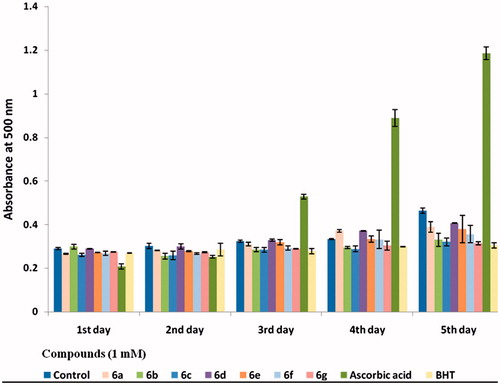Figures & data
Table 1. In vitro antioxidant activities of compounds 6 through DPPH, ABTS and FRAP methods.
Figure 2. Photomicrograph of testicular tissue (a) showing normal arrangement of different types of germ cells [spermatogonia (Sg), spermatocytes (Sp), spermatids (Sd) & sperms (Spm)] in control group; (b) treated with atrazine (100 nmol/ml) showing a number of pycnotic nuclei (P), crescent-shaped nuclei (arrow), chromolysis (ch) and vacuolization (V) within the seminiferous tubule; (c) treated with atrazine (100 nmol/ml) supplemented with compound 6e showing reduction in atretic changes induced by atrazine after 6 h of exposure; (d) treated with atrazine (100 nmol/ml) supplemented with compound 6g showing decline in number of chromolysis, condensation and fragmentation; (e) treated with atrazine (100 nmol/ml) supplemented with compound 6f showing protection against atrazine-induced cytotoxicity. H&E (×1000).
![Figure 2. Photomicrograph of testicular tissue (a) showing normal arrangement of different types of germ cells [spermatogonia (Sg), spermatocytes (Sp), spermatids (Sd) & sperms (Spm)] in control group; (b) treated with atrazine (100 nmol/ml) showing a number of pycnotic nuclei (P), crescent-shaped nuclei (arrow), chromolysis (ch) and vacuolization (V) within the seminiferous tubule; (c) treated with atrazine (100 nmol/ml) supplemented with compound 6e showing reduction in atretic changes induced by atrazine after 6 h of exposure; (d) treated with atrazine (100 nmol/ml) supplemented with compound 6g showing decline in number of chromolysis, condensation and fragmentation; (e) treated with atrazine (100 nmol/ml) supplemented with compound 6f showing protection against atrazine-induced cytotoxicity. H&E (×1000).](/cms/asset/14cbfb13-1541-4a6d-ae28-d26e5d2b8907/ienz_a_960864_f0002_c.jpg)


